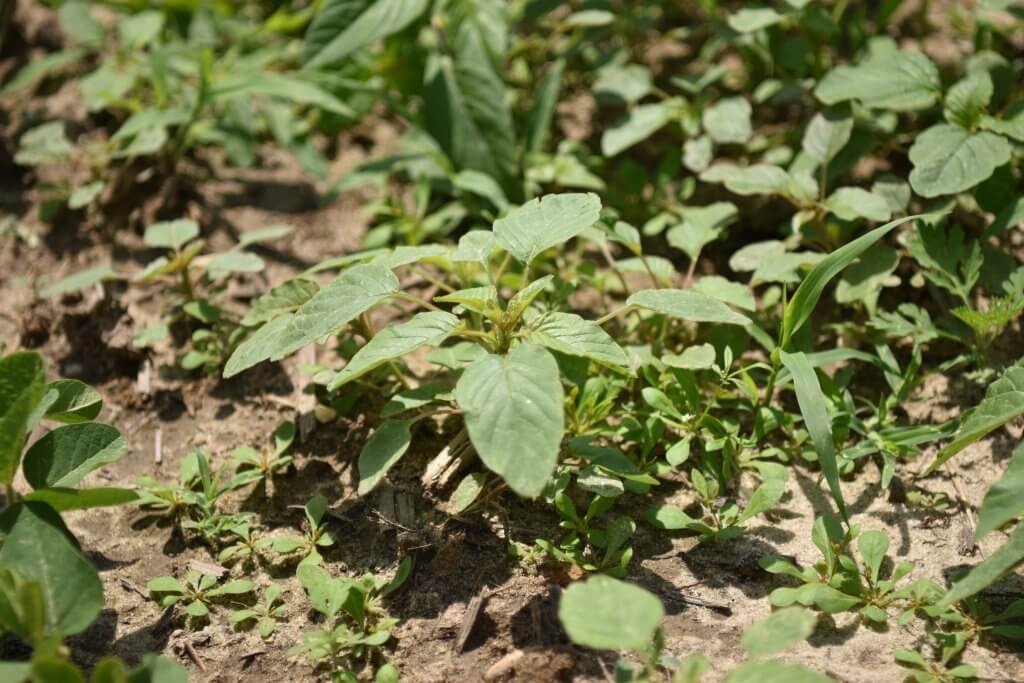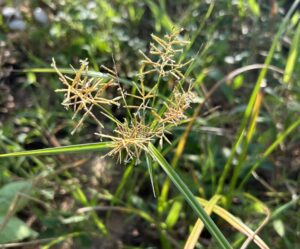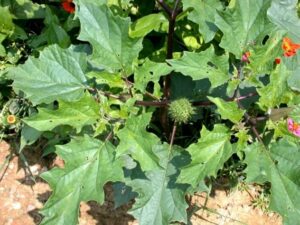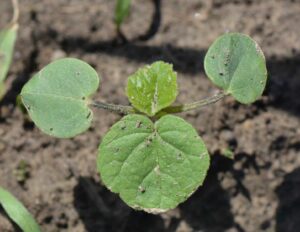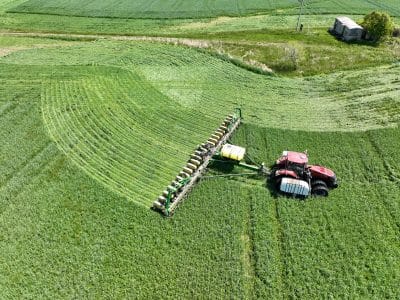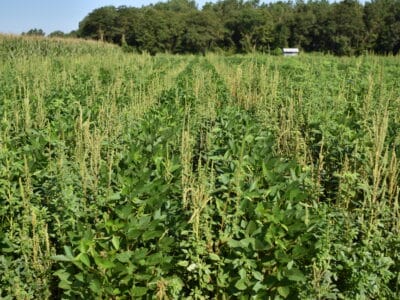Amaranthus palmeri S.Wats.
Also known as Palmer pigweed or careless weed
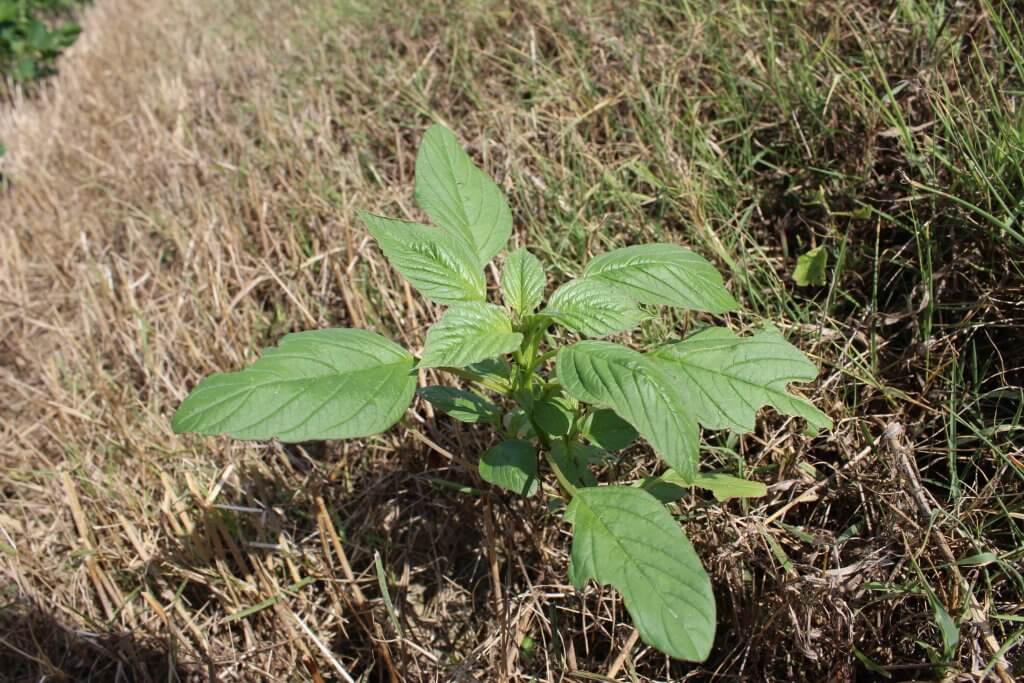
Biology
Palmer amaranth is a summer annual broadleaf weed from the Amaranthaceae (pigweed) family. It is native to the Sonora Desert and is well adapted for growth under hot, dry conditions. Mature Palmer amaranth plants can grow to over five feet tall with very thick stems, often 2 to 3 inches in diameter. Palmer amaranth is very competitive and capable of causing dramatic yield losses. Comparing yield loss in soybeans from different pigweed species, Palmer amaranth was more competitive than waterhemp or redroot pigweed. Competitiveness is due to its rapid growth during the seedling stage and its ability to continue growing at temperatures well over 95 °F. In fact, 95 to 114 °F is considered the optimum temperature range for photosynthesis. With adequate soil moisture, plants can grow over one inch per day during summer months. Furthermore, plants often develop a long lateral root within a few inches of the soil surface to maximize water uptake under dry conditions. Other traits that make Palmer amaranth fiercely competitive include copious seed production, season-long emergence, and ability to develop resistance to herbicides.
Palmer amaranth can be challenging to distinguish from other pigweed species, but the stems, petioles, and leaves are hairless. Palmer amaranth has diamond-shaped leaves, with petioles that are long (often as long as or longer than the leaf blade), which causes the leaves of mature plants to droop.

Palmer amaranth is a dioecious plant which means there are separate male and female plants. The male plants produce pollen that is wind disseminated to female plants. Mature female plants produce stiff bracts in the seedheads that become prickly. Seeds are small, shiny, black, and smooth.
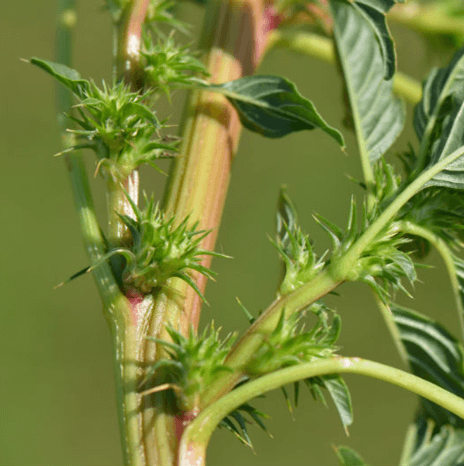
Where is Palmer amaranth a problem?
Historically, Palmer amaranth has been a problem in the cotton-producing states in the southern US. In the early 2000s its range expanded and it is now found in almost all states in the continental US and in Canada. It can infest all summer field crops, as well as vegetables, fruits, and forages. It is also found along roadsides and field edges. There is speculation that Palmer amaranth is less competitive in cool environments and this may limit the spread of Palmer amaranth in northern regions where it may be less troublesome.
What is the emergence pattern of Palmer amaranth?
Palmer amaranth emerges in the spring and continues throughout the summer until frost. The emergence timeframe of Palmer amaranth is longer than most other summer annual weeds. In many parts of the US, fall-emerging plants can complete their life-cycle and produce viable seeds prior to frost.
Emergence occurs primarily from those seeds in the top inch of the soil due to the limited carbohydrate reserves in the small seeds. Seeds are viable in the seedbank for a relatively short period of time; studies have shown 85% or more of the seeds lose viability within three years.
Emergence patterns are similar in no-till and conventional tilled systems. While the total number of emerged seedlings is often larger with conventional tillage, the timing of emergence has not been shown to be consistently impacted by tillage.
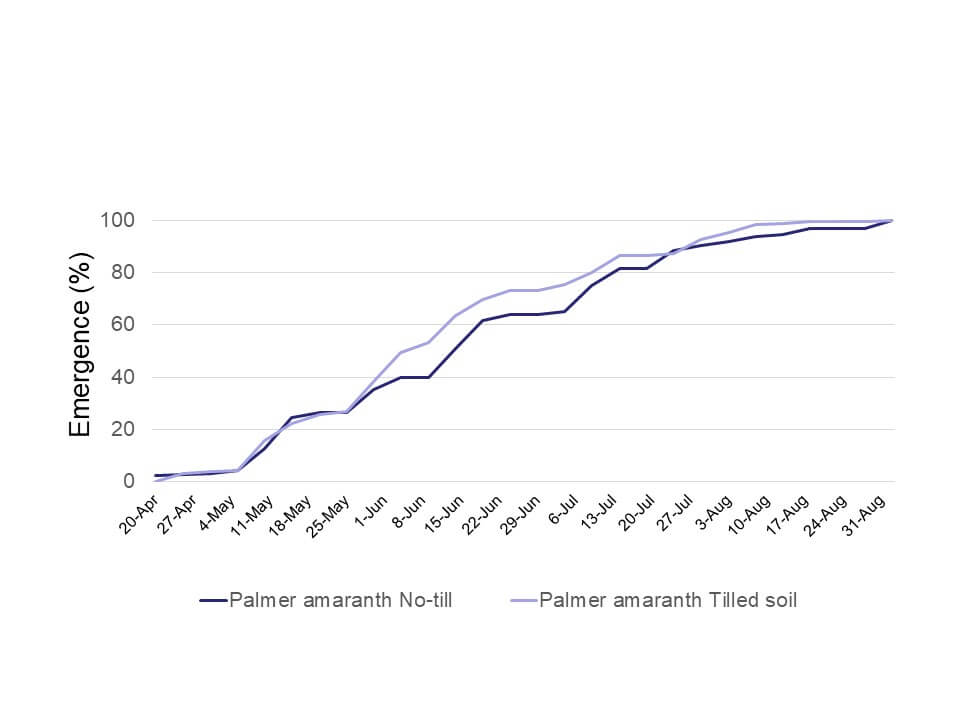
A study conducted in Arkansas reported that final Palmer amaranth height, biomass, and seed production were similar if plants emerged in spring and through June. But plants emerging in July and through the fall were progressively shorter, with less biomass and fewer seeds. The growth rate (plant height and biomass production) of Palmer amaranth is greater during the warmer summer months. For instance, four week old seedlings were 4, 7, or 13 inches tall when they emerged in April, May, or June, respectively.
What is the lifecycle of Palmer amaranth?
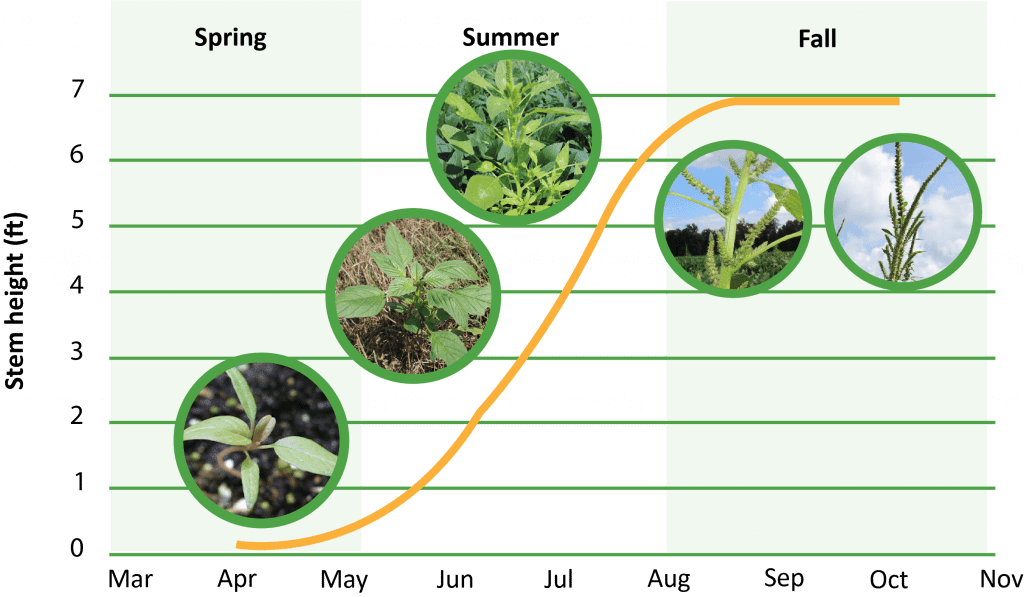
In regions with delayed frost, or only light frosts, Palmer amaranth plants are still green when most grain crops have reached full maturity. This can complicate harvest and increase foreign matter in the harvested grain.
How does Palmer amaranth spread?
Palmer amaranth is an annual species spread primarily by seeds. Due to the number of seeds produced per plant, the potential of moving seeds from field to field (or from region to region) is higher than most species. In-field spread occurs with human activity as well by ecological processes. Palmer amaranth seeds have low densities and can float on water. As a result, heavy rainfall or irrigation water flowing through a field can spread seeds within fields and in waterways. Palmer amaranth seed is readily distributed within fields and between fields by combines and other equipment.
In many cases, the genes for resistance are spread via pollen. Since Palmer amaranth is a dioecious species, the resistance trait can be spread quickly within fields.
How did Palmer amaranth get to North Carolina?
Dr. Wes Everman explains how one infestation of Palmer amaranth made its way from the Southwestern US to North Carolina.
New infestations often can be traced back to lack of prevention such as seed contamination in cover crop seeds, cotton or grain screening used as livestock feed, or transported with equipment/machinery. Harvesting infested fields (or portions of an infested field) last and thoroughly cleaning the combine before moving to the next field can limit spread.
How many seeds can Palmer amaranth produce and how long can those seeds survive?
A single female plant grown in a non-competitive environment with adequate moisture can produce over 600,000 seeds. Palmer amaranth plants in South Carolina emerging between 15-inch soybean rows in late July were able to produce ~130,000 seeds/plant. In Delaware, plants emerging after September 1 produced up to 1,300 seeds per plant before the first killing frost.
Seeds remain viable in the soil for a relatively short period of time. Field trials have documented only 15% of the seeds in the top four inches of soil remain viable after three years. However, when seeds were buried 16 inches, survival rate increased to 22% after three years.
What other biological weaknesses does Palmer amaranth have that can be targeted with management techniques?
Practices that shade the soil such as cover cropping or narrow row spacing can suppress weed seed germination and reduce seedling growth. Mature Palmer amaranth plants retain seeds in the seed head at maturity; this provides an opportunity to pull and hand remove mature plants without the seeds shattering and spreading as they are moved out of the field. This also allows use of harvest weed seed control tactics.
Herbicide Resistance
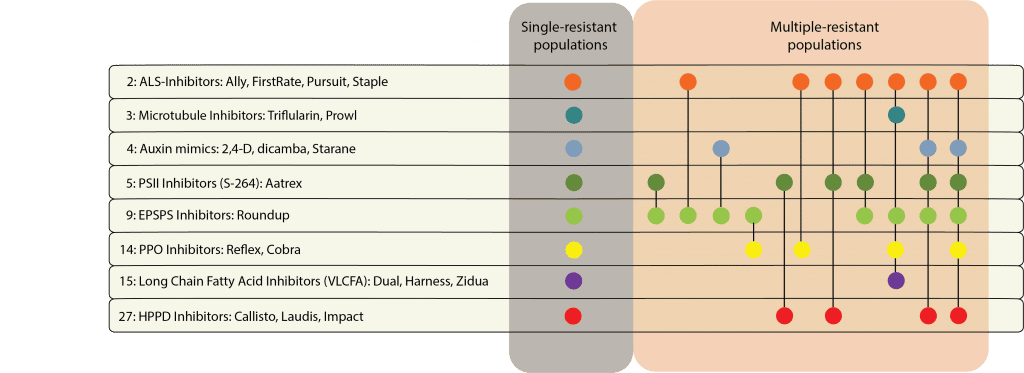
Contact your local extension office for details about resistance in your area and management options.
*Herbicide names are listed as representative products that contain these specific active ingredients. Please check herbicide labels for more information.
Integrated Weed Management Strategies
Cultural practices that favor rapid crop establishment and vigorous early growth will help in overall management of Palmer amaranth. Establishing a dense crop canopy quickly is very important. Palmer amaranth emergence and growth is suppressed by shade from cover crops, cover crop residues, and crop canopies. Enhancing crop canopy development with good agronomics and narrow row spacings can improve overall weed control by reducing emergence and slowing seedling growth.
Suppressing Palmer amaranth growth with narrow soybean row spacing
Planting crops in narrower rows can reduce the time for crops to shade out weeds and improve crop competitiveness. This video illustrates the benefits of planting soybeans in narrower row widths to improve weed control.
Crop rotation is an important strategy for Palmer amaranth management. In addition to the application of different herbicide modes of action, it allows for planting crops at different times, when Palmer amaranth growth may not be as rapid. Corn planting often occurs before temperatures rise, when Palmer amaranth’s growth rate is slower. Including small grains in the rotation allows treatment at mid-summer when a larger percentage of Palmer amaranth plants have emerged and can be controlled with non-selective herbicides. Taller growing crops also improve suppression of Palmer amaranth. For instance, Palmer amaranth control was improved with grain sorghum compared to soybeans, when using similar herbicide programs. Including cover crops in the rotation can also improve Palmer amaranth management (Figures 4 and 5).
Scouting and proper identification of Palmer amaranth is important. Palmer amaranth looks similar to other pigweed species, but is much more aggressive than most of these others. Since Palmer amaranth is known to evolve herbicide resistance, a zero-tolerance approach is recommended irrespective of economic thresholds for management. Scouting is important to be sure management tactics are done in a timely manner and to detect any potential new resistance.
Cover crops can reduce the number of Palmer amaranth plants emerging over the course of the season. Furthermore, cover crops may slow the growth of Palmer amaranth seedlings. The longer cover crops are allowed to grow and the closer cover crop termination occurs to crop planting, the greater effect cover crops have on Palmer amaranth growth. Due to the prolonged emergence of Palmer amaranth, even short periods between cover crop termination and planting of the cash crop can influence Palmer amaranth suppression. Likewise, cover crop species with lots of leaves and fleshy stems (i.e. legumes) do not persist as long and do not provide suppression for as long compared to cereal cover crops that produce a lot of stems resistant to rapid decay.


Prevention is also an important but often overlooked management strategy. Clean seed-containing mud from equipment and footwear before entering the field, harvest infested fields last, and buy certified seed when possible, to avoid weed seed contamination. Thoroughly clean the combine before harvest. Harvest herbicide-resistant weed-infested fields last. Plan your harvest ahead of time to avoid or minimize within the field and between field spread of weed seeds.
Mechanical weed control can help with overall weed control. Primary tillage that buries Palmer amaranth seeds by inverting the soil (moldboard plowing) is an effective way of reducing seedling emergence. However, moldboard plowing a second time within a few years can return buried seeds back to the soil surface where they have a chance to germinate and emerge. Therefore, moldboard plowing for Palmer amaranth management should only occur once every four or more years. “Strategic tillage” that is done selectively to target only fields (or portions of the field) with severe infestations and done infrequently so viable seeds are not returned to the soil surface is an effective approach.
As an annual species, Palmer amaranth is susceptible to soil disturbances, either primary tillage or interrow cultivation. Tillage is very effective for small seedlings (less than 3 inches tall), but as plants increase in size, cultivation is less effective as stems are capable of re-rooting and continuing growth.
The stems of larger Palmer amaranth plants have the ability to develop roots if they are uprooted and allowed to remain exposed at the soil surface. This can result in plants surviving tillage and hand-pulling, allowing these plants to produce seeds for the next generation.
Stale-seedbed (or false-seedbed) is less effective on Palmer amaranth than many other species due to the extended germination period.
Mowing Palmer amaranth along nearby roadsides or field edges can decrease seed production, but will not kill plants. In many situations, repeated mowing prior to seed production is needed to eliminate seed production. Mowing plants with mature seeds may result in spreading the infestation.
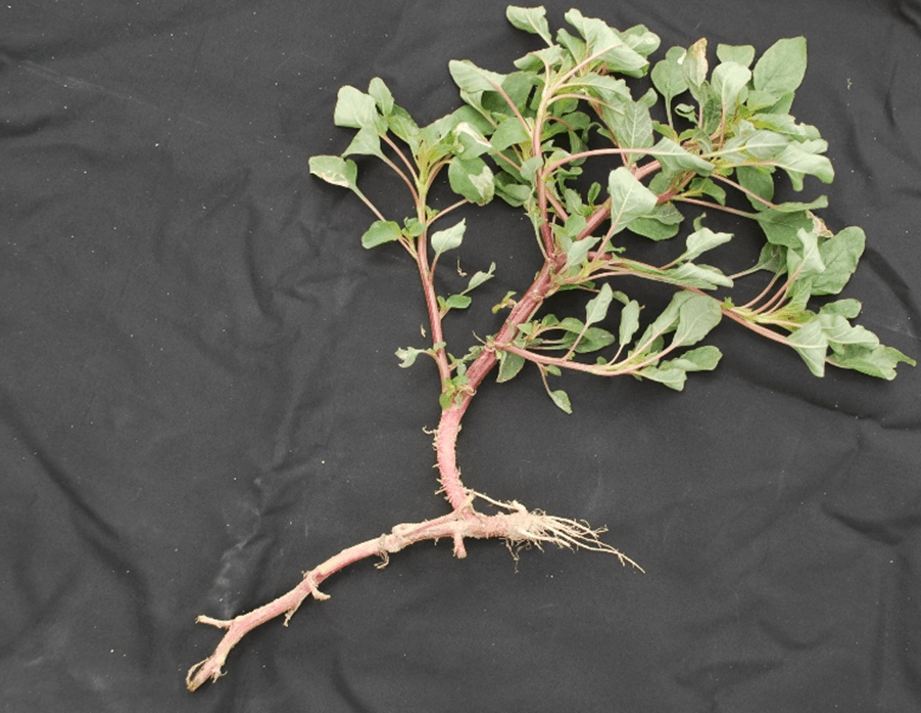
In addition to hand removal, other harvest weed seed control (HWSC) tactics include harvesting infested fields/areas last and cleaning equipment before moving to the next field (see video); concentrating weed seeds in narrow bands in the field rather than spreading them across the field; or destroying seeds during the combine process. Palmer amaranth retains a very high percentage of its seeds (up to 98%) up to 4 weeks after soybean harvest, so seeds are unlikely to fall when hand pulling or using mechanical methods to gather seeds.
Chemical weed control requires use of multiple effective modes of action, full-labeled rates, and application at the correct timing. The prolonged germination period coupled with rapid growth rate requires a greater level of management to ensure herbicides are applied at the correct time. Plant into a weed-free field using an effective non-selective herbicide prior to planting or using tillage just prior to planting. Preemergence or residual (or soil-applied) herbicides should be applied close to crop planting to provide the maximum amount of residual control after planting. Most residual herbicides will provide three to five weeks of residual control depending on herbicide, soil type, rainfall, and soil temperatures. Palmer amaranth control for summer grain crops requires both a preemergence and postemergence herbicide application. Postemergence applications need to be applied to Palmer amaranth at 3-4 inches in height. Applications to taller Palmer amaranth do not provide consistent control. Adding a residual herbicide to the postemegence application is recommended due to the season-long emergence of Palmer amaranth. It is recommended to use two or more effective modes of action with all herbicide applications to assist with herbicide resistance management as well as provide more consistent control.
Herbicide selection for Palmer amaranth has become more challenging due to multiple resistance in some populations. Consult your local extension educator or crop advisor for the presence of herbicide-resistant populations in your area. Whenever spraying Palmer amaranth be sure there are two effective modes of action being applied.
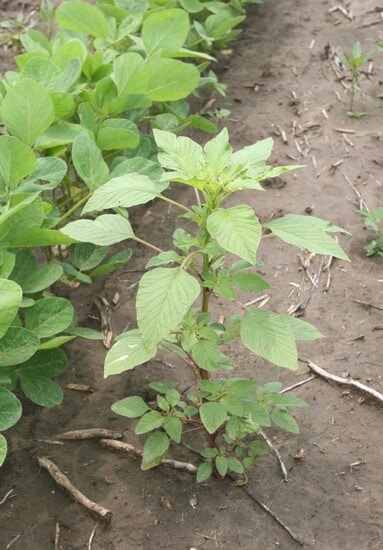
Gramoxone [Group 22 (paraquat)] and 2,4-D or dicamba (Group 4) can be used prior to planting in most states, although there are some populations resistant to Group 4 herbicides (see Graph 1). Soil-applied herbicides that will provide residual control include Group 3 herbicides such as pendimethalin (Prowl H2O), trifluralin (Treflan); Group 5 herbicides metribuzin (numerous) and atrazine; Group 7 herbicides including linuron (Lorox), diuron (numerous), fluometuron (Cotoran); Group 12 herbicide fluridone (Brake); various Group 14 herbicides including fomesafen (Reflex), sulfentrazone (Authority products), and flumioxazin (Valor); and Group 15 herbicides acetochlor (Harness/Warrant), pyroxasulfone (Zidua), and S-metolachlor (Dual II Magnum). While the above herbicides are available alone, they are also available as pre-packaged mixtures, so be sure to check herbicide labels for active ingredients. Of the burndown, preemergence, and postemergence application timings, the most effective herbicide modes-of-action are preemergence herbicides. Make sure to take advantage of this diversity when planning a herbicide program.
Postemergence control of Palmer amaranth requires treatment with herbicide before the weeds reach four inches in height (this can be challenging since plants may grow more than one inch per day). Resistance to glyphosate (Roundup) and Group 2 herbicides [such as imazamox (Raptor) and chlorimuron (Classic)] is widespread and, therefore, resistance should be assumed nationwide. Resistance to Group 14 herbicides [such as fomesafen (Reflex or Flexstar) and lactofen (Cobra)] is also common. Group 14 herbicides can be used if resistance is not suspected and Palmer amaranth is less than four inches tall; good spray coverage is critical. Group 27 herbicides [mesotrione (Callisto), tembotrione (Laudis), and topramazone (Impact or Armezon)] are highly effective when used in combination with atrazine. Postemergence control with glufosinate [Group 10 (Liberty, Cheetah, Interline, others)] is effective if applications are made when Palmer amaranth is less than 3-4 inches tall, with good coverage (15 GPA or more, medium droplets). In appropriate crops and with favorable environmental conditions, dicamba (i.e. Clarity, Diflexx, Engenia, XtendiMax) or 2,4-D (Enlist) can provide effective control. Postemergence herbicides should be applied with the addition of an overlapping soil residual herbicide, such as site of action Group 15 [acetochlor (Warrant), dimethenamid (Outlook), pyroxasulfone (Zidua), S-metolachlor (Dual II Magnum)].
Using products that are premixes of multiple effective ingredients or tank mixes from these groups is an important strategy for maximizing control and slowing the evolution of resistance. However, review the label or consult your local extension to be sure the active ingredients in the premix are at “full labeled rate”, meaning the rate is equivalent to recommended rates when the active ingredient is applied alone.
Refer to your local extension’s weed management guide for effective options. For more information on chemical Palmer amaranth management, visit:

Biological control of Palmer amaranth relies on ecological processes since no commercial products are available. There are leaf-feeding insects that attack Palmer amaranth but the damage caused seldom kills the plant or stops seed production. Seeds on (or near) the soil surface are often consumed by rodents and invertebrates, and ground cover can increase the density of these seed predators. Wildlife (i.e. ducks and geese) will also consume Palmer amaranth seeds, however, if seeds remain viable through the animal’s digestive system, the seeds can be dispersed.
Similar Weed Species
Palmer amaranth is closely related to other pigweed species: waterhemp (Amaranthus tuberculatus), redroot pigweed (Amaranthus retroflexus), smooth pigweed (Amaranthus hybridus), Powell pigweed (Amaranthus powellii), and spiny amaranth (Amaranthus spinosus). The table below compares the characteristics of the most common pigweeds in North America.
| Characteristic | Palmer amaranth | Waterhemp | Spiny amaranth | Redroot pigweed* | Smooth pigweed* | Powell amaranth |
| Stem hairs | No | No | No | Yes | Yes | Yes |
| Leaf shape | diamond-shaped | long, narrow | egg-shaped | egg-shaped | egg-shaped | egg-shaped |
| Petiole length | long, often as long as leaf blade | medium, half the length of the leaf blade | medium, 1/2 inch spines where petioles attach to stem | short | short | short |
| Separate male/female plants | Yes | Yes | No | No | No | No |
| Seedhead | long, slender; female seedhead is prickly | smooth, long, slender | male flowers at top and female middle and bottom of the plant | prickly, short, stout | slightly prickly, long, slender | prickly, long, thick |
| Watermarks | Occasionally | No | Often | No | No | No |
*Separating redroot pigweed from smooth pigweed relies on sepal/tepal length at maturity:
-Sepals of redroot pigweed are about twice as long as the seed and often curved outward
-Sepals of smooth pigweed are the same length as seed
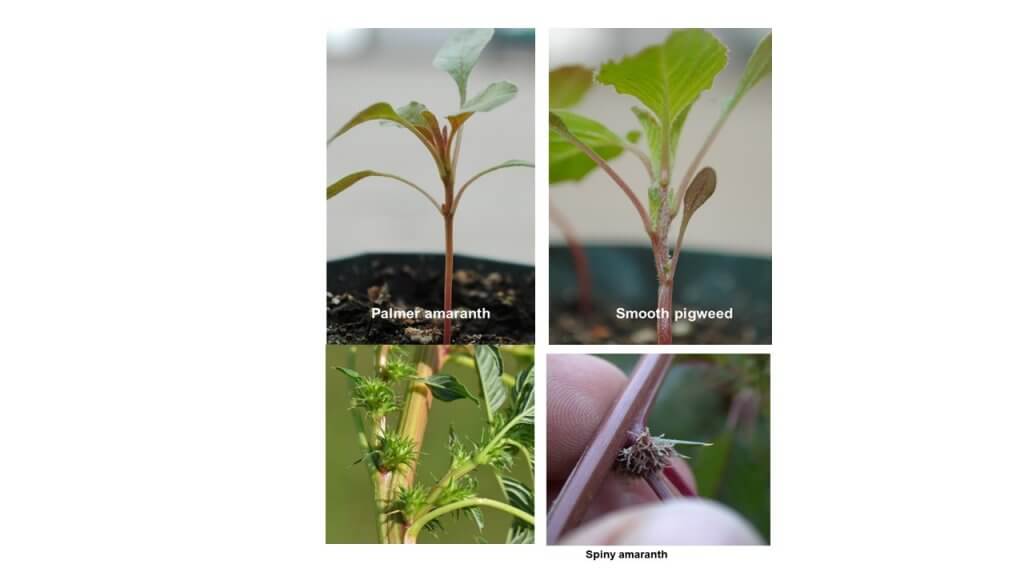
Authors
- Mark VanGessel
Editors
- Victoria Ackroyd
- Kreshnik Bejleri
- Michael Flessner
- Eugene Law
- Lauren Lazaro
- Steven Mirsky
- Claudio Rubione
Reviewed by:
- Sarah Lancaster
- Scott Nolte
Resources
Butts TR, Barber LT, Norsworthy JK (2020) Distribution and management of herbicide-resistant Palmer amaranth in Arkansas. University of Arkansas Cooperative Extension, FSA2188 6pp https://www.uaex.uada.edu/publications/PDF/FSA2188.pdf
Culpepper AS, Vance JC (2020) Palmer amaranth control in Georgia cotton – back to the basics. University of Georgia Extension 2pp http://gaweed.com/HomepageFiles/2020%20Cotton%20-%20final.pdf
Heap I (2021) The International Herbicide-Resistant Weed Database www.weedscience.org
Horak MJ, Peterson DE, Chessman DJ, Wax LM (1994) Pigweed Identification: A pictorial guide to the common pigweeds of the Great Plains. Kansas State University Cooperative, Kansas State University, S-80 12pp https://bookstore.ksre.ksu.edu/pubs/s80.pdf
Pratt DB, Owen MDK, Clark LG, Gardner A (1999) Identification of the weedy pigweeds and waterhemps of Iowa. Iowa State University Extension and Outreach, PM-1786, 19 pp. https://store.extension.iastate.edu/product/Identification-of-the-Weedy-Pigweeds-and-Waterhemps-of-Iowa
Take Action: Pesticide Resistance Management (2021) Palmer amaranth. https://growiwm.org/factsheets/https-growiwm-org-wp-content-uploads-2024-12-updated-palmer-factsheet_nov-2024_no-cc-pdf/. Accessed: January 29, 2022
Citations
Bensch CN, Horak MJ, Peterson D (2003) Interference of redroot pigweed (Amaranthus retroflexus), Palmer amaranth (A. palmeri), and common waterhemp (A. rudis) in soybean. Weed Science 51:37–43 doi.org/10.1614/0043-1745(2003)051[0037:IORPAR]2.0.CO2;
Jha P, Norsworthy JK (2009) Soybean canopy and tillage effects on emergence of Palmer amaranth (Amaranthus palmeri) from a natural seed bank. Weed Science 57:644–651 doi.org/10.1614/WS-09-074.1
Keeley PE, Carter CH, Thullen RJ (1987) Influence of planting date on growth of Palmer amaranth (Amaranthus palmeri). Weed Science 35:199–204 http://www.jstor.org/stable/4044391
Norsworthy JK, Schrage BW, Barber TL, Schwartz LM (2016) Emergence date influences growth and fecundity of Palmer amaranth in cotton. Journal of Cotton Science 20:263-270 http://www.cotton.org/journal/2016-20/3/upload/JCS20-263.pdf
Korres NE, Norsworthy JK, Young BG, Reynolds DB, Johnson WG, Conley SP, Smeda RJ, Mueller TC, Spaunhorst DJ, Gage K, Loux M, Kruger G, Bagayathiannan. MV (2018) Seedbank persistence of Palmer amaranth (Amaranthus palmeri) and waterhemp (Amaranthus tuberculatus) across diverse geographical regions in the United States. Weed Science 66:446-456 doi.org/10.1017/wsc.2018.27
Korres NE, Norsworthy JK, Mauromoustakos A, Williams MM (2020) Soybean density and Palmer amaranth (Amaranthus palmeri) establishment time: effects on weed biology, crop yield, and economic returns Weed Science 68:467-475. doi.org/10.1017/wsc.2020.41
Price AJ, Monks CD, Culpepper AS, Duzy LM, Kelton JA, Marshall MW, Steckel LE, Sosnoskie LM, Nichols RL (2016) High-residue cover crops alone or with strategic tillage to manage glyphosate-resistant Palmer amaranth (Amaranthus palmeri) in southeastern cotton (Gossypium hirsutum). Journal of Soil and Water Conservation 71:1-11 doi.org/10.2489/jswc.71.1.1
Shyam C, Borgato EA, Peterson D, Dale JA, Jugulam M (2021) Predominance of metabolic resistance in a six-way-resistant Palmer Amaranth (Amaranthus palmeri) population. Frontiers in Plant Science doi.org/10.3389/fpls.2020.614618
Sosnoskie LM, Webster TM, MacRae AW, Grey TL, Culpepper AS (2012) Pollen-mediated dispersal of glyphosate-resistance in Palmer amaranth under field conditions. Weed Science 60:366–373 doi.org/10.1614/WS-D-11-00151.1
Ward SM, Webster TM, Steckel LE (2013) Palmer amaranth (Amaranthus palmeri): a review. Weed Technology 27:12-27 doi.org/10.1614/WT-D-12-00113.1
Webster TM, Grey TL (2015) Glyphosate-resistant Palmer amaranth (Amaranthus palmeri) morphology, growth, and seed production in Georgia. Weed Science 63:264-272 doi.org/10.1614/WS-D-14-00051.1


